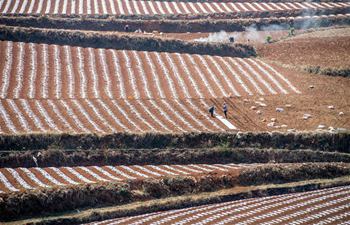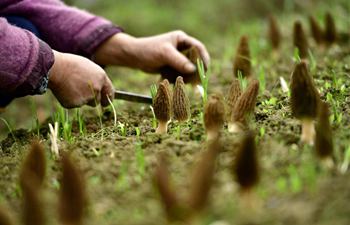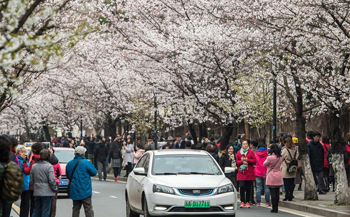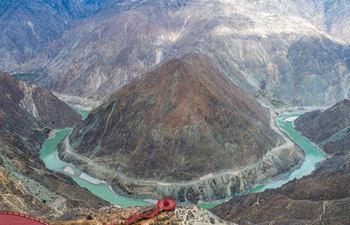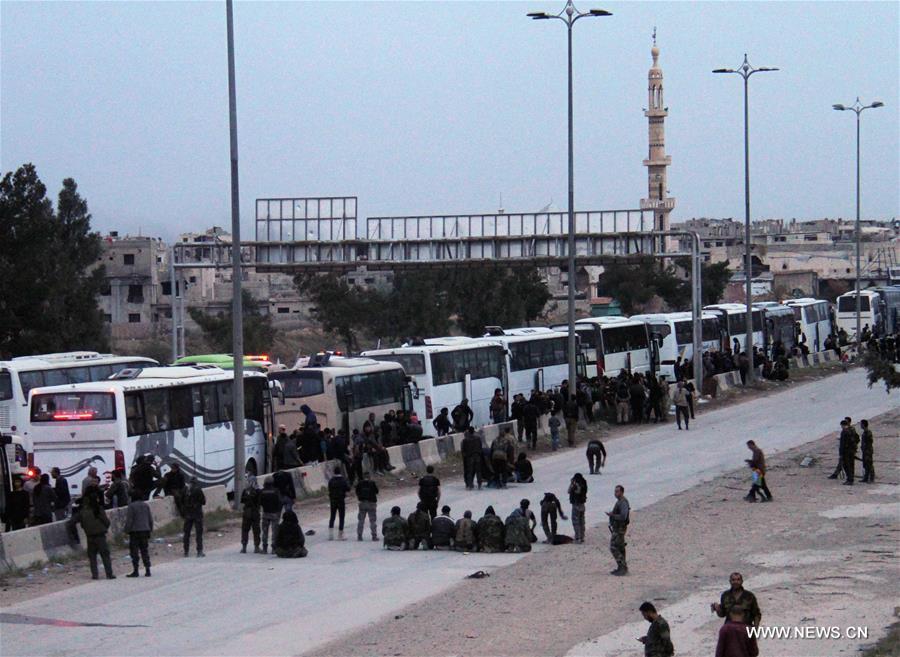
Buses transport rebels and their families as they leave the capital Damascus' Eastern Ghouta countryside, Syria, on March 23, 2018. The Syrian army has seized control of 90 percent of the capital Damascus' Eastern Ghouta area amid rebels' requests to leave under heavy military offensive. (Xinhua/Ammar Safarjalani)
DAMASCUS, March 23 (Xinhua) -- The Syrian army has seized control of 90 percent of the capital Damascus' Eastern Ghouta area amid rebels' requests to leave under heavy military offensive.
The military offensive, launched by the Syrian army, aimed to wipe out the rebels' presence in Eastern Ghouta, the last remaining threat to the capital.
Taking control of Eastern Ghouta would completely secure the capital that has been suffering from the rebels' mortar and rocket attacks for seven years.
Several key developments happened on Friday.
The city of Harasta, which overlooks the main highway between Damascus and the central and northern region, has been declared rebel-free, after the last batch of rebels and their families left that area towards rebel-held areas in northern Syria.
The evacuation from Harasta started on Thursday and ended Friday evening, with a total of 59 buses transporting 3,000 people, including 1,000 rebels and 2,000 of their families.
The rebels in Harasta have handed over their heavy weapons to the Syrian army before leaving Harasta towards rebel-held areas in the northwestern province of Idlib.
The TV broadcasted live footages of the entrance of Harasta with Syrian soldiers, celebrating and chanting for Syrian President Bashar al-Assad.
The TV titled its coverage as "Harasta is empty of terrorists," as the Syrian government regards most of the rebels as terrorists.
Also Friday, an agreement has been reached for the evacuation of rebels and their families from other key areas in Eastern Ghouta.
As many as 7,000 rebels and their family members are to leave areas of Jobar, Zamalka, Arbeen, and Ayn Tarma in Eastern Ghouta, and the deal covers the main rebel groups in control of those areas, namely the Failaq al-Rahman, and the al-Qaida-linked Nusra Front.
The Russian-sponsored agreement will also see the release of kidnapped people by the rebels ahead of their evacuation and lists of names will be handed over to the Russian side, according to the report.
The evacuation will take place on Saturday at 9:30 a.m. (0730 GMT) after the rebels hand over maps of the tunnels they dug and mines they planted in the aforementioned areas.
The fresh deal comes a day after the Failaq al-Rahman group declared a unilateral ceasefire to negotiate its withdrawal from the region.
The War Media, the media wing of the Syrian army, reported that the Failaq al-Rahman rebels, or the Rahman Legion, declared a cease-fire in the central part of Eastern Ghouta as of midnight Friday.
These areas have been the launching pad for firing mortar and rocket shells on Damascus throughout the last seven years of crisis.
This development came as the Syrian army captured large swathes of Ayn Tarma on Thursday and Friday, which is a key stronghold of the Failaq al-Rahman rebels.
Meanwhile, the War Media said a total of 3,500 kidnapped people are expected to be released from the rebel-held Douma district in Eastern Ghouta on Friday night.
The 3,500 people have been kidnapped and kept by the rebels in Douma and their release is part of an agreement with the Syrian army that will also see the evacuation of 3,000 people with medical conditions from Douma, according to the report.
Douma is controlled by the Jaish al-Islam, or the Islam Army, rebels' group, which has so far been out of other agreements recently reached with other rebel groups in Eastern Ghouta.
The Britain-based oppositional watchdog group said Friday that as many as 120,000 people have so far evacuated rebel-held areas in Eastern Ghouta.
The latest batch was a total of 2,450 people that reached government-controlled areas through the Wafidin crossing northeast of Damascus on Friday, according to the Observatory.
The civilians have been fleeing out of Eastern Ghouta since March 14, and the number kept increasing whenever the Syrian army captured new areas in that sprawling area.
Eastern Ghouta, a 105-square-km agricultural region consisting of several towns and farmlands, poses the last threat to the capital due to its proximity to government-controlled neighborhoods east of Damascus and ongoing mortar attacks that target residential areas in the capital, pushing people over the edge.
Four major rebel groups are currently positioned inside Eastern Ghouta, namely the Islam Army, Failaq al-Rahman, Ahrar al-Sham, and the Levant Liberation Committee, known as the al-Qaida-linked Nusra Front.
The UN humanitarian agencies have sounded the alarm about the worsening humanitarian situation for 400,000 people in that region, where activists said around 1,000 people have been killed since late last month by the heavy bombardment and military showdown there.






